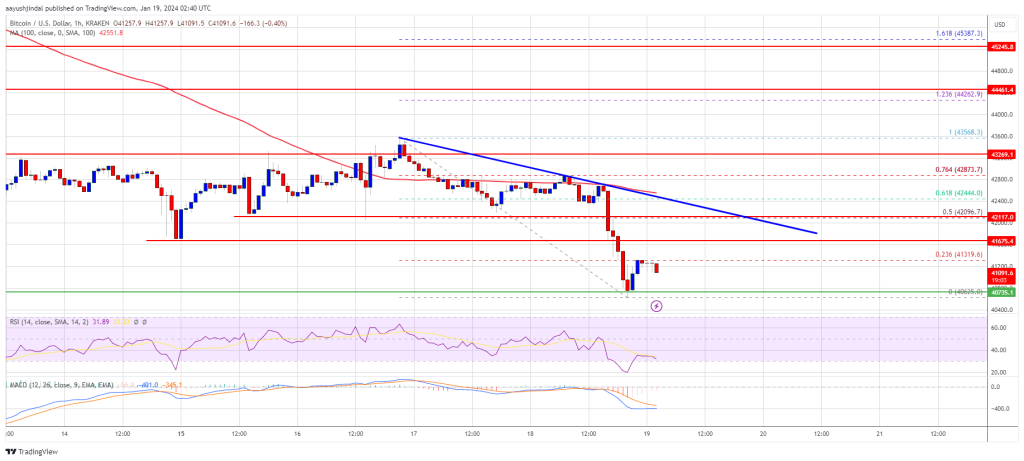Observers said BITO will remain an integral part of the market as a hedging instrument for authorized participants associated with the recently launched spot ETFs.
Bitcoin Whale Carries Out Massive Sell-Off As BTC Price Suppression Continues
An anonymous Bitcoin whale may have triggered a massive sell-off panic in the crypto market recently. According to an X (formerly Twitter) post by Ali Martinez, the whale sold off a whopping 59,000 BTC totaling over $2.45 billion.
Bitcoin Whale Dumps 59,000 BTC
In his X post, Martinez announced that a Bitcoin whale has initiated a large-scale dump, selling off approximately 59,000 BTC. He shared a chart displaying the Bitcoin Spend Output Age Bands which revealed that the Bitcoin whale had initially acquired 59,346.950 BTC during the last six months of 2023.
A staggering 59,000 $BTC, initially purchased 3-6 months ago at an average price of $26,000, was recently sold, netting an impressive 57.69% profit. This equates to a total gain of around $885 million! pic.twitter.com/cxubNOTFdQ
— Ali (@ali_charts) January 19, 2024
As per the crypto analyst’s estimate, the whale had bought this staggering amount of BTC at an average price value of $26,000. With BTC’s current value nearly doubling since the initial purchase, the whale’s 59,000 Bitcoin investment has yielded an outstanding 57.69% profit. This percentage puts the total gain at approximately $885 million.
This recent Bitcoin sell-off adds to a series of similar whale activities observed in the crypto space lately. Shortly after the launch of Spot Bitcoin ETFs, a Bitcoin whale sold 2,742 BTC worth $127.7 million at the time. This strategic move resulted in a substantial profit of over $74 million. Additionally, reports from Whale Alert have seen 6,621 BTC worth over $276 million being transferred from an unknown whale wallet to Coinbase, an American crypto exchange.
A whale deposited all 2,742 $BTC($127.5M) to #Binance to take profits after the #Bitcoin spot ETF opened trading.
The whale withdrew 2,742 $BTC($53M) from #Binance between Oct 7, 2022, and Dec 29, 2023, at an average price of $19,337.
The profit exceeded $74M! pic.twitter.com/1O96Z9ihie
— Lookonchain (@lookonchain) January 12, 2024
Usually, in the crypto space, small amounts of Bitcoin transactions have no effect on the market, but a transaction involving hundreds of millions, or billions of dollars worth of Bitcoin can potentially create massive selling pressure and adversely influence the price of the cryptocurrency.









6,621 #BTC (276,835,439 USD) transferred from unknown wallet to #Coinbasehttps://t.co/foR4QhUxQH
— Whale Alert (@whale_alert) January 19, 2024
In respect to this, popular market intelligence platform, Santiment disclosed on X that the crypto market has been consistently experiencing declines that could induce panic among traders.
#Crypto continues seeing concerning declines with the totality of market caps we track now down -7.5% in the past week. The #BitcoinETF approvals increasingly look to be a classic ‘buy the rumor, sell the news’ event, but it is still early. If traders begin to panic, their pic.twitter.com/G6v1OCVVzz
— Santiment (@santimentfeed) January 18, 2024
The crypto data intelligence platform shared a chart illustrating the dip possibilities that could be triggered by Fear, Uncertainty, and Doubt (FUD) among crypto traders and investors. Santiment predicts that if bearish sentiments cause traders to panic, it may prompt major sell-offs and potentially instigate a significant bounce in the market.
BTC Drops Below $42,000
Although 2024 has been heralded as the year of the crypto bull run, the price of Bitcoin has been experiencing unexpected declines recently.
Initially, BTC surged above $49,000, its highest level in 2023. However, currently the price of the cryptocurrency is trading below the $42,000 price mark. At the time of writing, Bitcoin’s price stands at $41,487, reflecting a 3.29% plunge over the past seven days, according to CoinMarketCap.
Despite the bullish sentiments brought by the approval and launch of Spot ETFs, Bitcoin has failed to rally above the $50,000 price mark predicted by expert crypto analysts. Santiment has suggested that the approval of Spot Bitcoin ETFs appears to be a classic case of a “buy the rumor, sell the news event.”
Featured image from Shutterstock
Bitcoin Spot ETFs Approved After 14 Years- The Journey So Far
The year 2024 marks the dawn of a new era, not just for technology but for finance, as a major victory was achieved for Bitcoin Spot ETFs (Exchang-Traded Funds). It’s now the era where the past will be appreciated for its foresight and doggedness.
When the pioneer cryptocurrency and digital currency, Bitcoin launched in January 2009, it was nothing like a real-world asset or of an ‘agreed’ digital value, but an almost neglected bag of gold as it faced enough rejection from all phases. Even with Satoshi’s Whitepaper, Bitcoin wasn’t given a cordial welcome in the world of finance.
However, for all its promise, BTC remained shrouded in an air of mystery and skepticism. It took several years for Bitcoin to cement its value in the world of technology, finance, and the digital economy, assuming a giant role amidst many other cryptocurrencies.
However, On January 10, 2024, the SEC, in its official filing, approves all 11 Bitcoin Spot ETFs. This long-awaited green light from the US SEC marked a watershed moment, not just for Bitcoin, but for the entire cryptocurrency industry.
The 14-year journey to this point was arduous and paved with skepticism; regulatory hurdles loomed large, with the SEC citing concerns about market manipulation and investor protection as justification for repeated rejections. Attempts like Bitcoin futures ETFs offered limited exposure, failing to capture the true essence of a spot ETF’s direct price tracking.
Bitcoin Spot ETF Explained
The recent approval of Bitcoin spot ETFs has stirred excitement across the financial landscape. But what exactly are these instruments, and what impact will they have on the future of BTC and, more broadly, on the investment landscape?
Bitcoin “Spot” ETFs (exchange-traded funds), unlike their futures-based counterparts, don’t track the price of Bitcoin futures contracts. Instead, they take a more direct approach, holding the underlying asset – Bitcoin itself – in secure digital custodians.
This eliminates the potential for “basis risk,” a phenomenon where futures prices deviate from the actual cash price of Bitcoin. Simply put, Spot ETFs offer a more straightforward and transparent way to gain exposure to BTC’s price movements, akin to traditional gold-backed ETFs.
Bitcoin Spot ETFs function similarly to their traditional counterparts, such as those tracking stock market indices. They pool investor capital, purchasing Bitcoin and holding it securely. Each share of the ETF represents a fractional ownership of the pooled Bitcoin, allowing investors to participate in the market without directly holding or managing the cryptocurrency themselves. This eliminates technical complexities and potential security risks, particularly for those with limited crypto experience, potentially broadening the base of Bitcoin investors.
The Genesis Of Bitcoin ETFs (Early Days and Conceptualization – 2013-2017)
The earliest sparks of a Bitcoin ETF concept date back to 2013, when the Winklevoss twins first proposed their Gemini ETF. Winklevoss twins, Cameron and Tyler, both tech entrepreneurs with a vision in 2013, submitted the first application for a Bitcoin ETF, the Gemini ETF, sparking the decade-long journey to regulatory approval.
This audacious proposal was outrightly rejected by the SEC during the tenure of its former chairman, Jay Clayton, who later resigned in 2020 and became a supporter of cryptocurrency. Interestingly, Clayton is now actively involved in crypto regulations when he joined the advisory board of Fireblocks, a crypto custody platform.
The following years were a crucible of innovation and uncertainty. While Bitcoin’s market capitalization surged, attracting both fervent supporters and cautious observers, the SEC remained hesitant. The regulator’s concerns about market manipulation, price volatility, and the nascent state of blockchain technology were cited as justifications for repeated rejections of subsequent ETF proposals, including Grayscale’s attempt to convert its Bitcoin Investment Trust into a spot ETF.
Yet, amidst the rejections, there were flickers of progress. Technological advancements improved blockchain security and custody solutions, addressing initial concerns about vulnerability and potential wash trading. The global adoption of Bitcoin, particularly in Canada with its approval of Spot ETFs in 2021, served as a compelling case study for increased accessibility and market stability.
This period also saw the SEC’s stance slowly evolve. The appointment of Gary Gensler as SEC Chair in 2021 brought a newfound openness to dialogue and exploration of potential regulatory frameworks for cryptocurrencies. The approval of the first US-listed futures-based bitcoin ETF in October 2021, despite its limitations, offered a glimpse of what could be.
The Turning Point: A Decade Of Persistence Pays Off (2018-2023)
While the 2017-2018 crypto boom and subsequent crash sent shockwaves through the industry, it also served as a crucible, forging resilience and fueling a renewed focus on compliance and innovation. Industry figures like Grayscale, undeterred by previous rejections, continued to refine their proposals, incorporating crucial safeguards and addressing regulatory concerns.
This relentless pursuit of approval finally yielded results in 2023. In May, Cathie Wood’s ARK Investments filed for a spot bitcoin ETF, setting a definitive deadline for the SEC’s decision.
Then, in June, BlackRock’s entry into the arena with its own Spot Bitcoin ETF application sent ripples of excitement through the financial world. This move by a traditional financial giant signalled a crucial shift in sentiment, demonstrating growing institutional confidence in BTC’s potential.
The months that followed were a whirlwind of activity. A flurry of applications from firms like Fidelity and Invesco poured in, fueled by the momentum of BlackRock’s move and the prospect of imminent approval. In August, a pivotal legal victory for Grayscale in the D.C. Circuit Court further strengthened the case for spot ETFs, forcing the SEC to re-examine its previous rejections.
Finally, the SEC, in a historic decision, greenlighted 11 spot bitcoin ETF proposals, including those from BlackRock, Fidelity, and VanEck. This moment marked the culmination of a decade-long struggle, signifying the mainstream acceptance of investor participation in the cryptocurrency space.
Ripples Across The Crypto Landscape: Implications Of Bitcoin Spot ETFs (2024)
The arrival of spot ETFs has cast a wide net, sending ripples across various spheres of the financial world. There are a lot of potentials and challenges presented by spot ETFs, vital impact on market stability, institutional adoption, and regulatory oversight. There are positive predictions that the Bitcoin market cap could rise above $1 Trillion after the launch of Bitcoin Spot ETFs.
Let’s contemplate the broader significance of this pivotal moment, what it means for the future of finance, and its relationship between technology and traditional financial systems here.
Investor Crossroads
For retail investors, Spot ETFs offer a convenient and familiar way to participate in the Bitcoin market without directly holding the cryptocurrency. This opens the door to broader adoption and increased liquidity, potentially leading to smoother price discovery and reduced volatility. The influential American magazine, Forbes predicted the BTC price will trade as high as $80,000 as a result of Bitcoin Spot ETFs’ approval.
The year 2024 is also shaping up to be a good one, if not one of the best seasons for cryptocurrency, especially Bitcoin, as it’s the season for Bitcoin halving, which will have another mega impact on the crypto industry.
However, the inherent risks of Bitcoin, including price fluctuations and potential exposure to fraud, must not be underplayed. Investors should approach spot ETFs with cautious optimism, ensuring a proper understanding of the technology, market dynamics, and associated risks before venturing in.
Institutional Embrace Bitcoin
The arrival of spot ETFs marks a significant step towards institutional acceptance of Bitcoin. The involvement of established financial institutions like BlackRock and Fidelity lends credibility to the cryptocurrency and paves the way for further integration with traditional financial products and services.
Concerns remain about the impact of institutional involvement on market manipulation and potential conflicts of interest. However, regulatory oversight and robust compliance frameworks will be crucial in ensuring a fair and transparent market for all participants.
Market Redefined
Spot ETFs could potentially lead to greater market stability by introducing institutional investors and their risk management expertise. This could mitigate some of the inherent volatility of the cryptocurrency market, attracting a wider range of investors and fostering sustainable growth.
The SEC’s approval represents a cautious acceptance, not a blank check. Further regulatory clarity and potential adaptation of existing frameworks might be required to effectively address the unique challenges posed by the integration of cryptocurrencies into mainstream financial systems.
Beyond Bitcoin
Spot ETFs could act as a gateway for investors to explore the broader crypto landscape. Their familiarity and ease of access might encourage exploration of other promising blockchain-based projects, accelerating the overall growth and development of the cryptocurrency ecosystem.
The success of spot ETFs will hinge on the continued evolution of blockchain technology and associated infrastructure. Scalability, security, and user experience will remain key areas of focus for ensuring the smooth functioning and widespread adoption of crypto-based financial products.
The 11 Spot Bitcoin ETFs products (with their ticker symbols) approved on January 10, 2024, are:
- Blackrock’s iShares Bitcoin Trust (IBIT)
- ARK 21Shares Bitcoin ETF (ARKB)
- WisdomTree Bitcoin Fund (BTCW)
- Invesco Galaxy Bitcoin ETF (BTCO)
- Bitwise Bitcoin ETF (BITB)
- VanEck Bitcoin Trust (HODL)
- Franklin Bitcoin ETF (EZBC)
- Fidelity Wise Origin Bitcoin Trust (FBTC)
- Valkyrie Bitcoin Fund (BRRR)
- Grayscale Bitcoin Trust (GBTC)
- Hashdex Bitcoin ETF (DEFI)
Conclusion
The approval of Bitcoin spot ETFs is a watershed moment, not just for the cryptocurrency itself, but for the entire financial landscape. It marks a new chapter in the saga of Bitcoin, one where its disruptive potential can be harnessed within the framework of established financial systems.
Also, this path forward is paved with both opportunities and challenges. Navigating regulations and addressing investor risk concerns are important to ensure seamless integration with traditional financial systems and regulatory bodies, which will be crucial in determining the ultimate success of this technological leap.
Final Thoughts
The approval of Bitcoin spot ETFs is not merely a regulatory green light; it’s a resounding declaration of Bitcoin’s arrival on the main stage of finance.
Related Reading: Celestia Network: How To Stake TIA And Position For 5-Figure Airdrops
However, the journey is far from over. This approval is a milestone, not a destination. As we stand at this turning point, it’s important to remember the spirit of defiance that birthed BTC. It was born from a desire for autonomy, for freedom from centralised control, and for a more equitable financial system.
While ETFs offer a bridge between this decentralized world and the established financial order, it’s crucial not to lose sight of these core principles.
Bitcoin Whale Addresses Hit 15-Month High – A Sign Of Growing Accumulation?
The story has not been much different for the price of Bitcoin this week, as the premier cryptocurrency has struggled to capitalize on its recent advancements. According to data from CoinGecko, BTC is down by more than 3% in the past week, putting doubts over the continuation of the bull run.
However, the latest on-chain revelation has offered some relief, suggesting that the value of Bitcoin might be up for substantial recovery over the next few weeks.
Can Whale Accumulation Trigger Continuation Of Bull Cycle?
Popular crypto analyst Ali Martinez revealed – via a post on the X platform – that the number of Bitcoin whales has witnessed a significant increase over the past few days. This is based on the “Number of Entities With At Least 1,000 BTC Balance” metric from the on-chain analytics firm Glassnode.
According to the latest Glassnode data, the number of addresses holding at least 1,000 BTC surpassed 1,510 on Thursday, January 18. This figure represents the metric’s highest level in over 15 months (since August 2022).
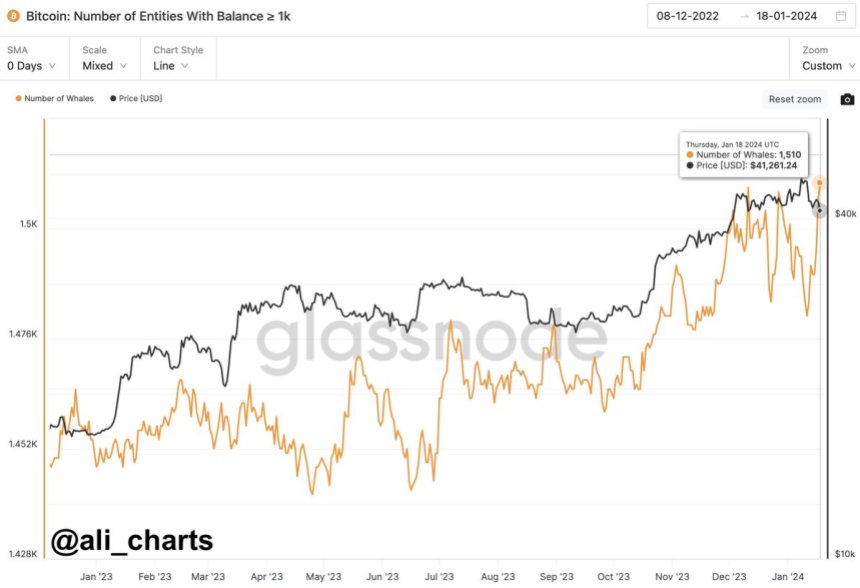
Large holders, commonly known as “whales,” are considered relevant entities in the cryptocurrency market due to their ability to influence prices and market sentiment. Hence, a notable uptick in the number of whales often suggests growing confidence in a cryptocurrency – in this case, Bitcoin.
Furthermore, this surge in whale addresses signals potential accumulation amongst large investors and institutions. Acquisition of large Bitcoin amounts is a positive sign for the market leader, especially in terms of price performance.
A recent Santiment report adds strength to this argument, saying that increased whale accumulation of Bitcoin would be a “key” factor to help trigger another bull run for the flagship cryptocurrency and the entire sector.
As the #crypto weekend begins, shark & whale tiers for #Bitcoin & top #stablecoins remain mildly down:
10-10K #Bitcoin wallets: 66.27% of supply
100K-10M #Tether wallets: 33.98% of supply
100K-10M #USDCoin wallets: 35.49% of supply
Several events can
(Cont)
pic.twitter.com/qu6SqG4Qis
— Santiment (@santimentfeed) January 20, 2024
The blockchain analytics firm also highlighted the accumulation of the Tether and USDC stablecoins as a vital signal for the cryptocurrency market’s return to its recent high.
Bitcoin Price Overview
As of this writing, the price of Bitcoin stands at $41,593, reflecting a 1.1% increase in the past 24 hours. This doesn’t fully tell the story of the coin’s performance in the past day, though, as it briefly fell below $41,000.
According to data from CoinGecko, BTC is down by more than 5% in the last 14 days. The cryptocurrency has reversed all its gains and more from the recent launch of spot exchange-traded funds in the United States.
Nevertheless, Bitcoin maintains its spot as the largest cryptocurrency in the sector, with a market cap of over $814 billion.
Fidelity Bitcoin Spot ETF Records $1 Billion In Net Inflows – Details
Data from the trading analytics platform BitMEX Research reveals that Fidelity’s Bitcoin spot ETF – FBTC – has now witnessed a total inflow of over $1 billion. This development comes as BTC attempts to rebound from its recent dip over the last two weeks with a 1.56% gain in the past day, based on data from CoinMarketCap.
Fidelity Joins BlackRock On Exclusive $1-B List, As Grayscale’s ETF Continues To Bleed
Following the official launch of Bitcoin spot ETF trading on January 11, Fidelity has now become the second asset manager, with its BTC spot ETF recording an accumulative inflow of $1 billion. According to BitMEX Research, Fidelity’s FBTC experienced an inflow of $177.9 million on January 18, bringing its total inflows to $1.1 billion within five days of trading.
FBTC now sits at the same table as BlackRock’s IBIT, whose total inflows are valued at $1.2 billion. Together, both investment funds by Fidelity and BlackRock now account for over 67% of the $3.4 billion inflows recorded in the Bitcoin spot ETF market so far.
Other Bitcoin spot ETFs with a notable positive performance include Bitwise’s BITB, Ark Invest’s ARKB, and Invesco’s BTCO, which have posted individual total inflows of $395.5 million, $320.9 million, and $194.8 million, respectively.
Bitcoin Spot ETF Flow data – Day 5
Data out for all providers
Net outflow of $131.6m on day 5 for all spot ETFs, large $579.6m GBTC outflow pic.twitter.com/McHZrRghtu
— BitMEX Research (@BitMEXResearch) January 19, 2024
On the other hand, Grayscale’s GBTC continues to experience outflows on a massive scale.
BitMEX Research reveals that GBTC recorded an outflow of $579.6 million on January 18, leading the Bitcoin spot ETF market to witness a net outflow of $131.6 million. This represented the second day the BTC spot ETF market recorded a net outflow since its launch.
GBTC’s total outflows are now valued at $2.1 billion, resulting in Bitcoin spot ETFs having a cumulative net inflow of only $1.3 billion despite the $1 billion status of BlackRock and Fidelity’s ETFs.

Bitcoin’s Price Overview
Against popular predictions, Bitcoin has witnessed a price decline in the last two weeks following the approval of the much-anticipated BTC spot ETF on January 10. Many analysts have attributed this unexpected development to the massive selling pressure generated by GBTC’s outflows.
At the time of writing, Bitcoin trades at $41,536, with a decline of 2.55% and 5.50% in the last seven and 14 days, respectively. As earlier stated, the premier cryptocurrency has garnered some gains of 1.56% in the last day, which may be indicative of a recovery, however, it is too early to call.
How Bitcoin Won The Heart Of This Financial Giant
Franklin Templeton President and CEO Jenny Johnson joined CNBC’s ‘Squawk Box’ to discuss the firm’s spot Bitcoin Exchange-Traded Fund (ETF) offering in the US. In this interview, Johnson shared the reasons for investing in Bitcoin.
What Made Franklin Templeton CEO A Bitcoin Believer
As she states in the interview, the CEO is known for saying that “Bitcoin is the greatest distraction from one of the greatest disruptions in financial services,” which has led many people to believe that she doesn’t support or believe in the crypto asset.
Contrary to this belief, she points out that the Franklin Bitcoin ETF (EZBC) launch shows the asset manager company’s belief in BTC and blockchain technology.
Johnson cites the security that Bitcoin provides as one of the reasons that made her a “believer.” Holding and managing your private keys, which she states doing at one point, gives the asset what she labels an “insurance or safety component.”
This component makes crypto investors trust Bitcoin more since there’s a “fear component” linked to traditional assets, as she explains:
One of the things that made me a believer is: as I went around the world talking to people who would tell you ‘I keep 50% of my savings in Bitcoin because if I save the wrong thing in my country, I could have my assets confiscated.’ I remember talking to somebody in Israel who said, ‘My parents and their parents had all of their assets confiscated’ and they keep a portion in Bitcoin. So, there’s a fear component to it that it’s considered almost an insurance or safety component.
The CEO also listed the importance of Bitcoin in “fueling what is the next real opportunity in this blockchain world,” another reason for her to believe in the asset.
Trust In Blockchain Technology
Regarding the reason behind the market’s demand that led to the spot Bitcoin ETF’s approval by the US Securities and Exchange Commission (SEC), the CEO thinks that there are various reasons for it, including Bitcoin’s crucial role, “from a blockchain standpoint,” in the ability to pay.
Johnson further explained that blockchain technology will “open a lot of really interesting tech investment opportunities,” as Bitcoin is “one of the suitable opportunities here.” Furthermore, the CEO recalled the asset manager’s previous use and trust in blockchain technology:
We actually launched and tokenized money market fund. We’re the first mutual fund or the first traditional asset manager to actually launch a 40-act fund on a public blockchain, on the stellar blockchain.
Lastly, when asked what can allure a traditional investor to invest in an ETF, she explains there’s a market and use case for both. But while holding your keys can be ideal for many, it may also be complicated to figure out.
ETFs can better fit some investors who want to diversify their portfolio while “being able to open it up, have access through an ETF, and simply through your account.”
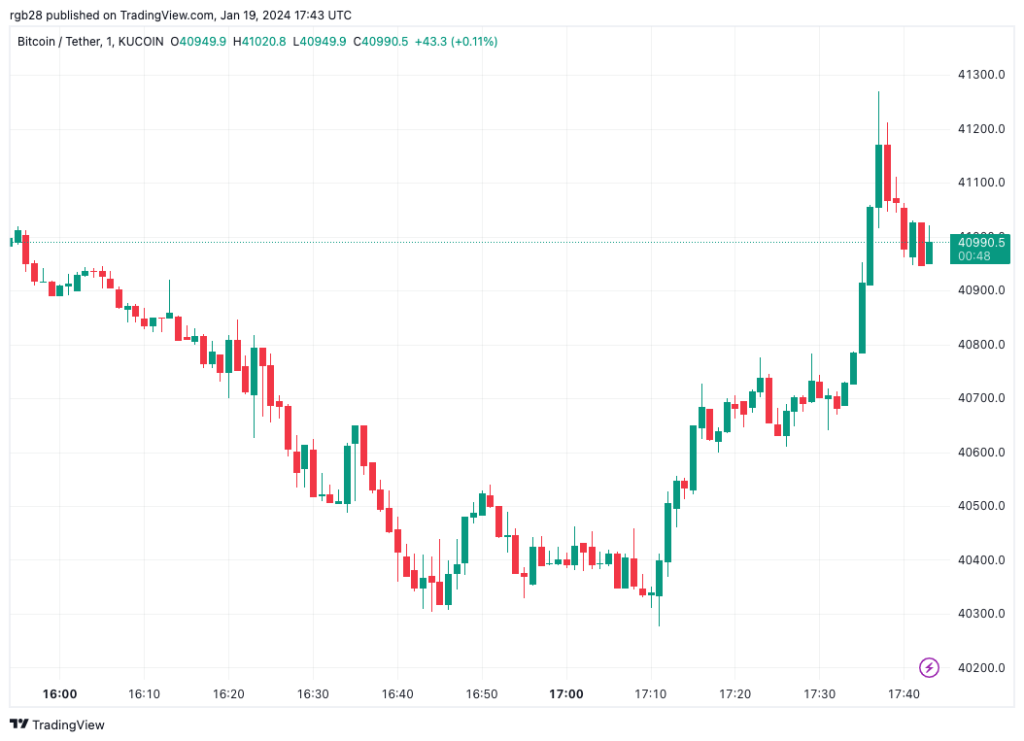
Bitcoin Accumulation: USDT Issuer Tether Goes On Massive 8,888 BTC Buying Spree
In an encouraging development for the crypto space, Tether, the issuer of the world’s largest stablecoin USDT, has doubled down on its Bitcoin investment momentum by acquiring a staggering 8,888 BTC, further diversifying its portfolio.
Tether Increases Its Bitcoin Holdings
Tether has recently made its third largest Bitcoin purchase, as the stablecoin issuer added a total of 8,888 BTC valued at $380 million at the time of purchase. This brings its total BTC holdings to 66,465 BTC, valued at $2.81 billion with an average buy price of $42,353.
This transaction was captured by BitInfoCharts data, which also showed the previous amounts of BTC accumulated by the blockchain-enabled platform. This recent purchase follows Tether’s Bitcoin investment strategy, in line with its vision to continuously strengthen its reserves by accumulating Bitcoin.
Earlier in May 2023, the stablecoin issuer announced in a blog post that it would regularly allocate 15% of its net realized operating profits toward increasing its BTC reserves. As of the end of March 2023, Tether held approximately $1.5 billion worth of cryptocurrency, a $1.3 billion difference from its total BTC holdings presently.
According to reports from Dune Analytics, Tether has become the 11th largest Bitcoin holder, with Microstrategy, an American business intelligence service, surpassing Tether’s holdings with over 189,00 BTC accumulated. The other addresses in the top 10 rankings are owned by major crypto exchanges and governments, including Binance, Bitfinex and the US government.
Tether’s decision to double down on its Bitcoin investments signals its confidence in the cryptocurrency’s future trajectory. It also underscores the blockchain platform’s belief in the long-term potential of BTC as it aims to capitalize on Bitcoin’s potential growth by bolstering and diversifying its digital asset reserve.
BTC Accumulation Race Amidst ETF Hype
Tether’s strategic Bitcoin purchase comes at a time when the crypto market is buzzing with excitement over Spot Bitcoin ETFs. Before the approval of Spot Bitcoin ETFs, Tether had steadily increased its BTC portfolio, purchasing substantial quantities of BTC consistently. In March 2023, the stablecoin issuer bought 15,915 BTC and another 4,083 BTC between the months of May and September.
The timing of Tether’s BTC purchase suggests a proactive stance towards potentially seizing the opportunities brought forth by the Spot Bitcoin ETF market and the upcoming Bitcoin halving in April.
In addition to Tether’s large-scale BTC acquisition, Microstrategy is also another major player which has been continually increasing its BTC holdings. The business intelligence software company added a whopping 14,620 BTC to its portfolio in December 2023. At the time, the value of the purchase was about $615.7 million.
Other companies with large BTC holdings include Galaxy Digital and Elon Musk’s Tesla, as well as space exploration company SpaceX.
Market Dips, Whales Play: Bitcoin And Ethereum Snagged By Savvy Investors
Recently, cryptocurrency analytics platform Lookonchain reported activities of Bitcoin (BTC) and Ethereum (ETH) whales amid the ongoing market downturn. These whales appear to have been capitalizing on the recent decline in the crypto prices to bolster their holdings.
According to Lookonchain, amid the market dip, a newly established wallet withdrew 700 BTC, valued at roughly $29.36 million, from the Binance exchange.
These BTCs were purchased at an average price of $41,948 each.It is worth noting that, according to the analyst, such a move during a market downturn demonstrates a bullish sentiment on the future of BTC.
It seems that a whale is buying $BTC!
In the recent market drop, a new wallet withdrew 700 $BTC($29.36M) from #Binance at an average price of $41,948.https://t.co/5kE1l0mJlo pic.twitter.com/Fj1thu4C6x
— Lookonchain (@lookonchain) January 19, 2024
Ethereum Whales Joining The Fray
The narrative of strategic accumulation isn’t limited to Bitcoin. Lookonchain’s subsequent tweet highlighted similar activities in the Ethereum market.
A whale took advantage of the decreased Ethereum prices, buying 3,600 ETH, worth around $8.9 million. Lookonchain highlighted that this investor’s history of buying ETH at lower prices and selling at higher valuations has resulted in substantial profits, estimated at around $25.8 million.
After the price of $ETH dropped today, this smart whale bought 3,600 $ETH($8.9M) back at a lower price 5 hours ago.
This whale is very good at buying $ETH at low prices and selling $ETH at highs.
The profit is ~$25.8M currently!https://t.co/UzXbheftr1 pic.twitter.com/DannZzsQVk
— Lookonchain (@lookonchain) January 19, 2024
These whale movements are worth noting, especially considering the increasing bearish sentiment in the cryptocurrency markets. Ethereum, for instance, has seen a 1.9% decline in the past 24 hours and a 7.8% drop over the past week.
The asset is currently trading at around $2,475. Bitcoin is experiencing a similar trend, with a nearly 3% decrease in the past 24 hours and a 10% fall over the past week, bringing its price to $40,819 at the time of writing.
This market downturn is also reflected in the asset’s trading volume. Bitcoin’s daily trading volume fell from over $40 billion last Friday to about $26 billion.
Bitcoin Market Analysis And Future Predictions
In light of these developments, renowned crypto analyst Jacob Canfield has cautioned that Bitcoin might face further corrections in the short term.
Canfield notes that the upcoming Bitcoin halving could play a crucial role in rebalancing the market dynamics, potentially tipping the scale towards demand over supply. However, his analysis of Bitcoin’s 4-hour chart indicates the formation of a trend that has historically been an indicator of negative short to mid-term price movements.
For Bitcoin, critical levels include $48,700, marked by the 61.8% Fibonacci retracement, weekly resistance, and a significant support level to watch at $38,700. Earlier this month, Bitcoin traded at the $48,700 zone before retracing.
Canfield warns that following a tap of the 61.8% level, Bitcoin often experiences an 18-22% sell-off, potentially bringing it back to the $38,700 support level.
#Bitcoin update – If you’ve been following me for a while, you’ll know my local top on $BTC was $48.7k (as per my playbook posts)
The question that everyone is asking now is ‘where do we go from here?’
The current narrative is that the ETF approval unlocked the GBTC investors… pic.twitter.com/MayIZp5vEY
— Jacob Canfield (@JacobCanfield) January 18, 2024
Featured image from Unsplash, Chart from TradingView
Bloodbath For Bitcoin: Grayscale’s $529 Million BTC Move To Coinbase Pushes Price Below $41,000
Bitcoin (BTC), the largest cryptocurrency in the market, has experienced a sharp drop below the $41,000 mark as exchange-traded funds (ETFs) for Bitcoin went live on January 12.
The subsequent profit-taking, selling pressure, and outflows from Grayscale’s Bitcoin Trust ETF (GBTC) played a significant role in the downward trend.
Grayscale’s Bitcoin Transfers To Coinbase Intensify
On Tuesday, NewsBTC reported that six days ago, Grayscale initiated the first batch of BTC outflows from their holdings to a Coinbase, totaling 4,000 BTC (approximately $183 million) over six days.
However, the asset manager resumed outflows from the Trust to the exchange on Tuesday, sending an additional 11,700 BTC (equivalent to $491.4 million) to Coinbase.
Furthermore, on Friday, data from Arkham Intelligence revealed that 12,865 BTC ($529 million) were transferred from the Grayscale Trust address to Coinbase Prime.
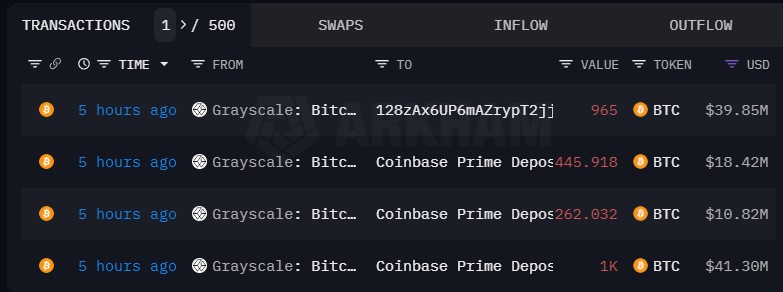
In total, the Grayscale Trust address has transferred 54,343 BTC ($2.313 billion) to Coinbase Prime during the opening hours of the US stock market over five consecutive trading days since January 12, which has undoubtedly contributed to the downtrend in Bitcoin’s price.
Selling Frenzy Among BTC Miners
In addition to Grayscale’s selling spree, there has been increased selling activity by Bitcoin miners ahead of the upcoming Bitcoin halving.
Crypto analyst Ali Martinez highlights that on-chain data from CryptoQuant indicates a substantial increase in selling activity by BTC miners. In the past 24 hours, miners offloaded nearly 10,600 BTC, with a value of approximately $455.8 million.
The persistent selling pressure has caused BTC to trade at $40,900, reflecting a slight 0.2% decrease over the past 24 hours.
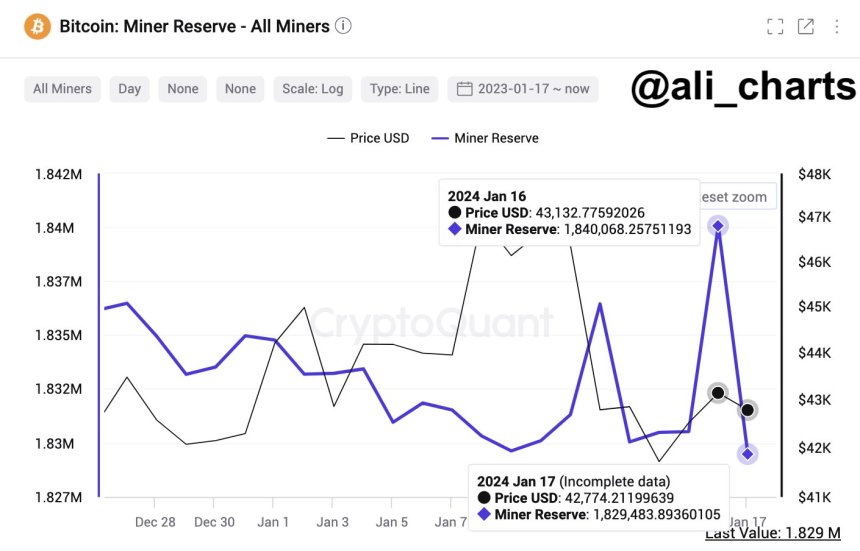
The downtrend has been evident across various time frames, with declines of 5%, 6%, and 7% over the seven, fourteen, and thirty-day periods, respectively. However, despite these recent setbacks, Bitcoin remains remarkably positive year-to-date, with an impressive 98% gain.
Overall, the combined impact of Grayscale’s Bitcoin Trust ETF outflows and increased selling activity by miners has intensified the downward pressure on Bitcoin’s price, breaching the critical support level of $41,000.
The focus now turns to how Bitcoin bulls will defend the crucial $40,000 support level, which stands as the last line of defense before a potential dip toward the $37,700 mark.
Should this support level fail to hold, the Bitcoin market could witness further price declines, potentially pushing the price down to the $35,800 mark. However, with the Bitcoin halving scheduled for April, bullish investors are hopeful that this event will catalyze a significant bull run.
Featured image from Shutterstock, chart from TradingView.com
Analyst: Until Bitcoin Retests $61k, The BTC Top Is Not In
Despite recent dips in price, Bitcoin is still on track for further gains, according to BitQuant. Based on technical analysis, the analyst predicts that the world’s most valuable coin will likely top out at $61,000, not $50,000, as some analysts have suggested.
Bitcoin Has Room For Growth, May Peak At $61,000
Sharing a screen grab on X, the analyst argues that based on Bitcoin’s history, prices tend to peak once it retests the 2X100 exponential moving average (EMA). So far, prices are lower, trading below $45,000, and the uptrend is valid despite the recent cool-off.
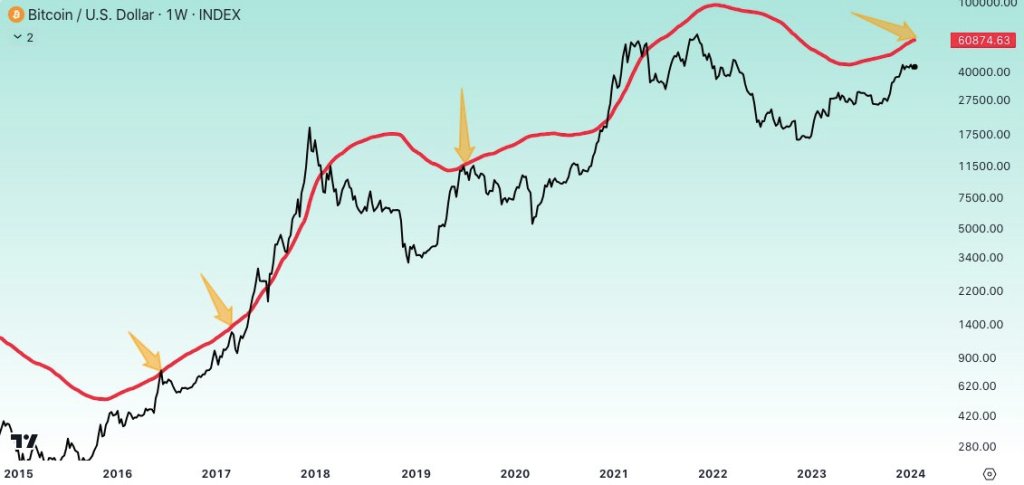
For this reason, BitQuant is confident that the recent drop was a temporary correction. Accordingly, BTC will likely extend gains, breaking above immediate resistance levels at $45,000 and even $50,000 in the short to medium term.
Still, it should be noted that the 2X100 EMA is a technical indicator and may lag. Since the indicator averages past prices, it might not be accurate, showing current events and expectations of prices.
To demonstrate, in the last bear market, Bitcoin prices dipped below the 2X100 EMA as the coin tanked to as low as $16,000 by November 2022. This development wasn’t expected by the community, taking adherents by surprise.
So far, looking at the Bitcoin price action in the daily chart, the path of least resistance is northwards. Though the approval of spot Bitcoin ETFs by the United States Securities and Exchange Commission (SEC) was expected to lift prices immediately, BTC unexpectedly crashed.
Bears appear in control, recently forcing prices below a short-term support level. For this reason, the immediate trend aligns with the January 12 bear engulfing bar. Making projections from this formation, BTC may, if bears take charge, drop to $40,000 or lower.
BTC Demand Surging
Even with this bearish outlook, the encouraging surge of capital to approved spot Bitcoin ETFs is bullish. Investor Fred Krueger notes that in the last five days alone, IBIT, the spot Bitcoin ETF issued by BlackRock, the world’s largest asset manager, received $1 billion.
Looking at the pace of inflows, not only IBIT but other spot Bitcoin ETFs, Krueger believes BTC is undervalued at spot rates. The investor estimates that spot Bitcoin ETF issuers now hold over 650,000 BTC, up from 619,000 BTC as of January 1. This suggests that institutional investors are increasingly bullish on Bitcoin, and prices, though depressed, might recover going forward.
Crypto Analyst Predicts Potential Trend For Bitcoin As Price Slips
Rekt Capital, a well-known cryptocurrency analyst and enthusiast, has revealed the potential directions that the price of Bitcoin could take in light of the upcoming fourth BTC Halving.
Potential Retracement For Bitcoin
With the halving event approaching, analysts are debating what steps Bitcoin should take after its recent breach from the macro downtrend. One of those is Rekt Capital, who has weighed in on the particular issue and made a comparison to past trends.
The crypto analyst shared his latest projections during one of his YouTube predictions videos for Bitcoin. In the video, Rekt Capital delves in on the “next possible steps” that BTC is anticipated to take while highlighting “a breakout from its macro downtrend.”
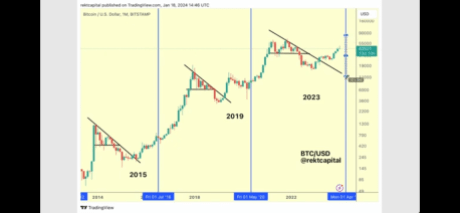
His analysis focuses mainly on the reaccumulation range that formed prior to the halving event in 2015-1016 period. He further drew a comparison between 2023-2024 and 2015-2016, while noting similarities between the two periods.
According to him, the trend that formed within that period has resurfaced in the current 2023-2024 period. “One of the things that contributes to that similarity is the reaccumulation that formed a few months before the halving,” he stated.
Rekt Capital pointed out the possibility of a retracement around the Bitcoin halving event. This is due to a scenario proposed by the crypto analyst in which a reaccumulation range break triggers a retreat.
An analogy to the cycle of 2015–2016 indicates a comparable rejection from a resistance level prior to the halving, which may have contributed to a possible retreat.
Furthermore, he has highlighted that such retracements are indicated by historical data but stresses that they are often brief. However, he asserted that after the retrace, which is the “last opportunity,” we would see a price increase for Bitcoin.
This surge will “turn the $46,000 price level into a new support level, and move to touch its old all-time high.” Rekt Capital also anticipates the price going beyond this level putting Bitcoin on a path to a new all-time high.
Factors The Buttress BTC Value, ETFs Not Included
Samson Mow, the Chief Executive Officer (CEO) of Pixelmatic, has revealed several factors that boost Bitcoin’s value. Mow took to X (formerly Twitter) to underscore these factors with the crypto community.
According to him, the value of Bitcoin is amplified by “scarcity, utility, and the failure of fiat.” Mow further insisted that BTC Spot Exchange-Traded Funds (ETFs) do not contribute to the token’s value.
His X post came in response to CNBC’s “Mad Money” host Jim Cramer’s post over his comments on BTC’s current action. Cramer asserted that “no one showed up” after the approval of BTC ETFs, which led to a decline in price.
Mow was displeased by Cramer’s claims, and he stated that many people were present while noting the net inflow. “A lot of people showed up. Just look at the net inflow and how much BlackRock, Fidelity, and others accumulated,” he stated.
In Search of Financial Freedom: The Answer Lies With Bitcoin, Not Stablecoins
Bullish Bitcoin Bets Rise as Implied Volatility Slides
Some traders bought bitcoin calls at strikes $45,000 and $46,000 during Thursday’s U.S. trading hours, according to over-the-counter institutional cryptocurrency trading network Paradigm.
First Mover Americas: Bitcoin Slips Over 15% Since ETF Approval
The latest price moves in bitcoin [BTC] and crypto markets in context for Jan. 19, 2024. First Mover is CoinDesk’s daily newsletter that contextualizes the latest actions in the crypto markets.
Why Did The Bitcoin Price Fall Below $41,000?
Bitcoin dropped below $41,000 in the last 24 hours before making a recovery to rise above that level once again. This has become the current reality of the flagship crypto token’s price, which has continued to decline since the Spot Bitcoin ETFs were approved. This is surprising considering that these funds were projected to help boost Bitcoin’s price upon launch.
Why Bitcoin’s Price Could Be Dipping
Bloomberg analyst James Seyffart provided insight into what could be the reason for Bitcoin’s declining price as he revealed that Grayscale’s GBTC has experienced an outflow of $2.2 billion since its conversion to a Spot Bitcoin ETF. Crypto analytics platform Arkham Intelligence also revealed that Grayscale had moved 9000 BTC from their wallets to Coinbase, suggesting an imminent sale.
A sell pressure of such magnitude would no doubt affect Bitcoin’s price, and that seems to be a plausible explanation for why Bitcoin’s price has declined as of late. The CEO of Jan3 and Bitcoiner, Samson Mow, also echoed similar sentiments as he mentioned that the GBTC sell pressure was pushing prices down.
However, Mow believes that this trend “won’t be a long drawn out process,” as he predicts that many of GBTC’s investors won’t be able to offload their stocks because the “tax hit is too big.” JP Morgan will, however, beg to differ as a research report by the bank estimates that up to $3 billion could exit from the GBTC fund with many investors looking to take profit.
Crypto analyst Ash Crypto also recently elaborated on how profit-taking is one of the reasons that GBTC is seeing this significant amount of outflows. He explained that a lot of GBTC investors bought shares in the fund when it was trading at a 40% discount from Bitcoin, and now they are exiting their positions since that discount is now at 0%.
Spot Bitcoin ETFs Are Actually Living Up To Hype
While Grayscale’s GBTC continues to bleed, other Spot ETFs look to be living up to the hype, with there being an impressive demand for these funds. Nate Geraci, the President of the ETF Store, revealed that two (IBIT and FBTC) out of the nine Spot ETFs (excluding GBTC) already hit $1 billion in assets under management (AUM) just after five trading days.
Specifically, BlackRock’s IBIT (iShares Bitcoin Trust) was the first to achieve this milestone in just four trading days. Commenting on how impressive this was, Bloomberg analyst Eric Balchunas noted that only two other ETFs ($GLD and $BITO) had done this before now, and none of those funds faced such competition as IBIT did on launch day.
The demand for Spot ETFs is evidently there, seeing that two spot Bitcoin ETFs have already achieved a record that was held by only two other ETFs before now.
Crypto Analyst Sounds Alarm: Bitcoin Price Set To Plunge Even Lower
The Bitcoin price experienced a further sell-off yesterday and fell by more than 5% intraday to as low as $40,660. Since the year-to-date high of $49,000 on January 11, the BTC price has dropped by as much as 17%. However, according to renowned crypto analyst Jacob Canfield, this may not be the end of the correction. In a recent analysis, Canfield warned that more downside could be on the cards in the short-term.
The analyst, known for accurately predicting the local top of Bitcoin, addressed the prevailing uncertainty in the market. “The question that everyone is asking now is ‘where do we go from here?’” the analyst posed, acknowledging the community’s growing concern.
A significant factor in the current market dynamics is the approval of a Bitcoin ETF, which has led to speculation about Grayscale Bitcoin Trust (GBTC) investors selling their holdings to evade the associated fees. The narrative is compounded by revelations from court filings that the FTX bankruptcy estate holds a substantial number of GBTC shares, approximately 22,280,720 (worth $744 million), poised for liquidation.
Conversely, signs of market optimism emerge with BlackRock’s ETF, IBIT, reportedly accumulating spot Bitcoin aggressively, adding up to 25,067 bitcoins in under a week. The analyst suggests that this buying momentum from BlackRock may eventually counterbalance the selling pressure from GBTC, especially when considering the impact of the upcoming Bitcoin halving, creating a ‘delayed impact’ event potentially tipping the scale towards demand over supply.
How Low Can Bitcoin Price Drop?
The chart analysis provides a more immediate and grim perspective. The Bitcoin 4-hour chart indicates a lost trend that’s now acting as resistance, historically a foreboding sign for short to mid-term price movements.
“The 4 hour trend on bitcoin has been lost and tested as resistance. This is not great as the 4 hour trend historically has been a good indicator for short term/mid term price movements, the analyst remarked.
Canfield further points out, “If I was looking for a level for a short term bounce, it would probably be at a sweep of the $40,000 liquidity,” hinting at potential downward pressure on the price.
The Bitcoin daily chart presents a narrow path, with significant levels at $48.7k, marked by the 61.8% Fibonacci retracement and weekly resistance, and a notable support level at $38.7k. “As I’ve noticed in former posts, after BTC taps the 61.8, it tends to sell off 18-22%, which would give us another crack at that $38.7k level as well,” warns Canfield.
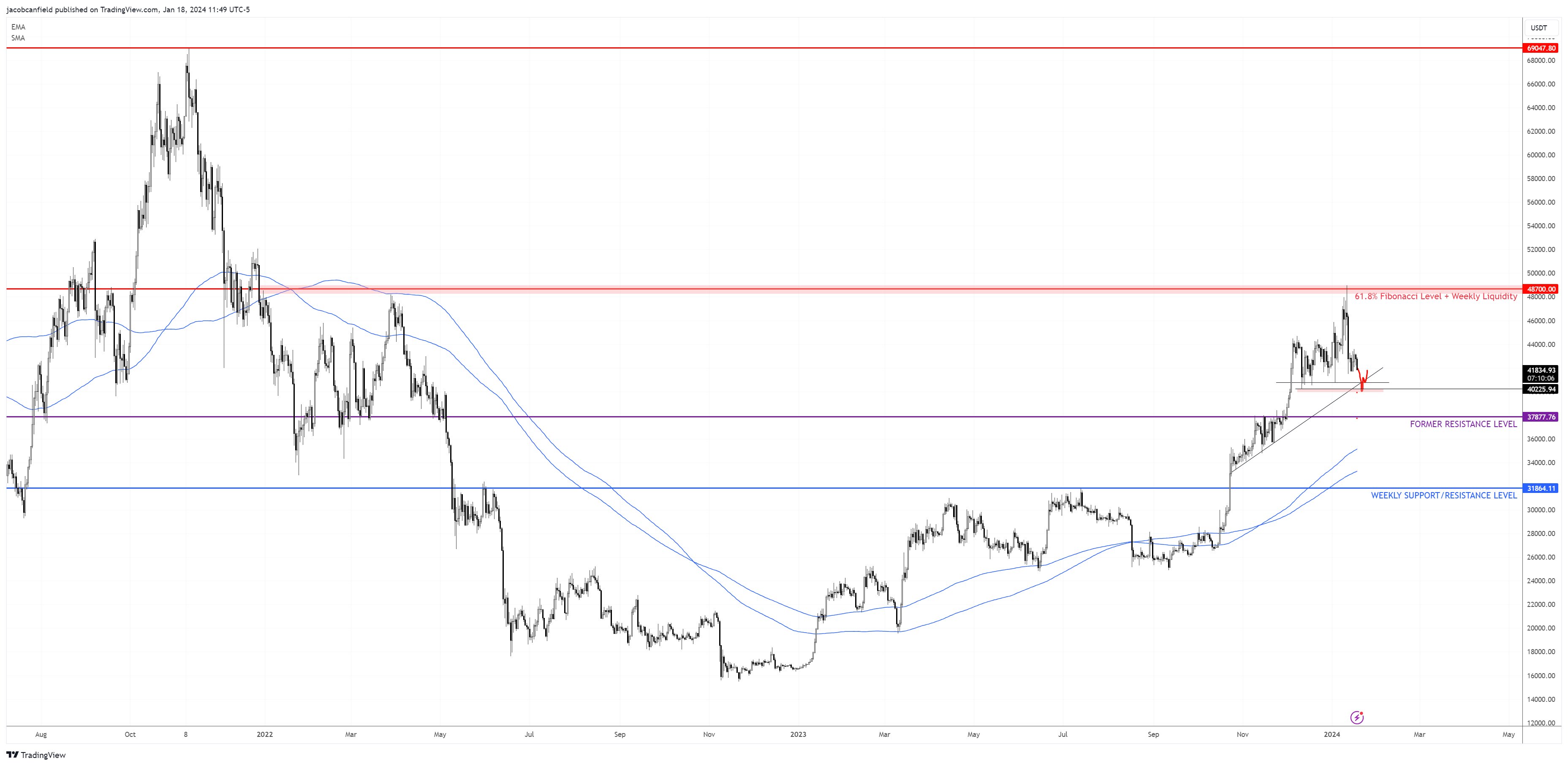
Furthermore, the daily 200’s (EMA/MA) are currently trending upwards, having previously acted as support, suggesting they might cushion a further price fall.
The analyst concludes with a word of caution, emphasizing the need for vigilance in the current market characterized by low volume and volatility, conditions that often precede substantial market movements: “Biggest thing I can stress is that caution is needed during low volume/low volatility environments as a big move typically follows.”
At press time, BTC traded at $41,178.
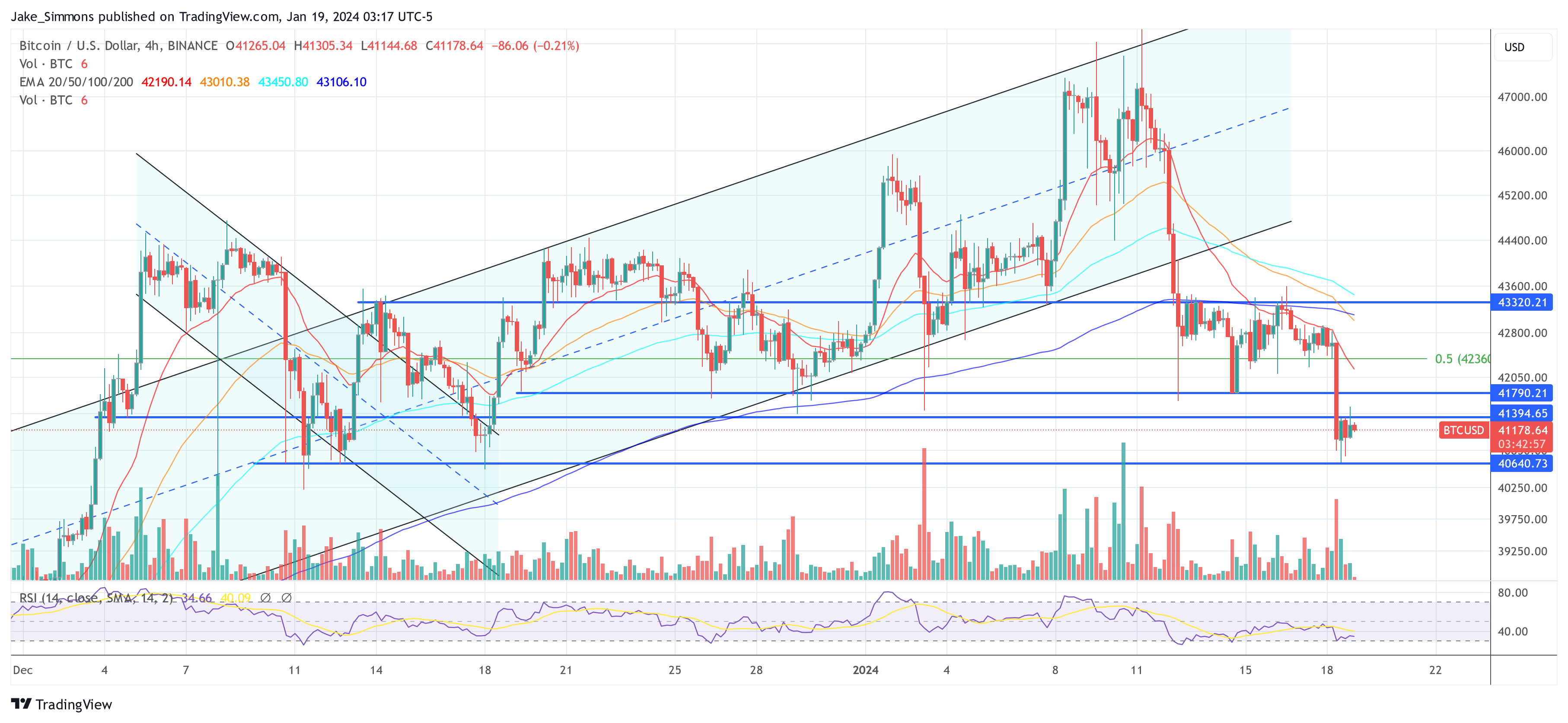
Ether Could Soar in 2024 on the Back of Dencun Upgrade, ETF Narrative: Analysts
The ether- bitcoin ratio has surged 10% in the first 19 days of the year, taking back part of last year’s 25% slide.
Crypto Bulls Lose $217M as Apparent Grayscale Sales Weighs on Bitcoin
Analysts also pointed out that GBTC shares flipped to a 0.9% discount on Thursday amid “likely selling pressure.”
Bitcoin Price Takes Hit, Can Bulls Protect The Main Support at $40K?
Bitcoin price extended its decline below the $41,450 support zone. BTC is showing bearish signs and might struggle to stay above the $40,000 support zone.
- Bitcoin price is gaining bearish momentum below the $42,500 zone.
- The price is trading below $42,000 and the 100 hourly Simple moving average.
- There is a key bearish trend line forming with resistance near $42,100 on the hourly chart of the BTC/USD pair (data feed from Kraken).
- The pair is now at risk of more downsides toward the $40,000 support zone.
Bitcoin Price Gains Bearish Momentum
Bitcoin price failed to start a recovery wave above the $43,250 resistance zone. BTC formed a short-term top and started another decline below the $42,120 support zone.
The bears were able to push the price below the $41,450 level. A new weekly low was formed near $40,625 and the price is now consolidating losses. It is trading near the 23.6% Fib retracement level of the recent decline from the $43,569 swing high to the $40,625 low.
Bitcoin is now trading below $42,000 and the 100 hourly Simple moving average. There is also a key bearish trend line forming with resistance near $42,100 on the hourly chart of the BTC/USD pair.
On the upside, the price is facing resistance near the $41,675 level. The next key resistance is near the $42,100 zone and the trend line. It is also close to the 50% Fib retracement level of the recent decline from the $43,569 swing high to the $40,625 low.
Source: BTCUSD on TradingView.com
A clear move above the $42,100 resistance could send the price toward the $43,250 resistance. The next resistance is now forming near the $43,500 level. A close above the $43,500 level could push the price further higher. The next major resistance sits at $44,450.
More Losses In BTC?
If Bitcoin fails to rise above the $42,100 resistance zone, it could continue to move down. Immediate support on the downside is near the $40,750 level.
The next major support is $40,500. If there is a close below $40,500, the price could gain bearish momentum. In the stated case, the price could drop toward the $40,000 support in the near term.
Technical indicators:
Hourly MACD – The MACD is now gaining pace in the bearish zone.
Hourly RSI (Relative Strength Index) – The RSI for BTC/USD is now below the 50 level.
Major Support Levels – $40,750, followed by $40,000.
Major Resistance Levels – $41,675, $42,100, and $43,250.
Bitcoin Plunges Below $41K as ‘Sell the Bitcoin ETF News’ Wins the Day
Despite sizable net inflows into the new spot ETFs, bitcoin is lower by more than 12% since the products began trading one week ago.
